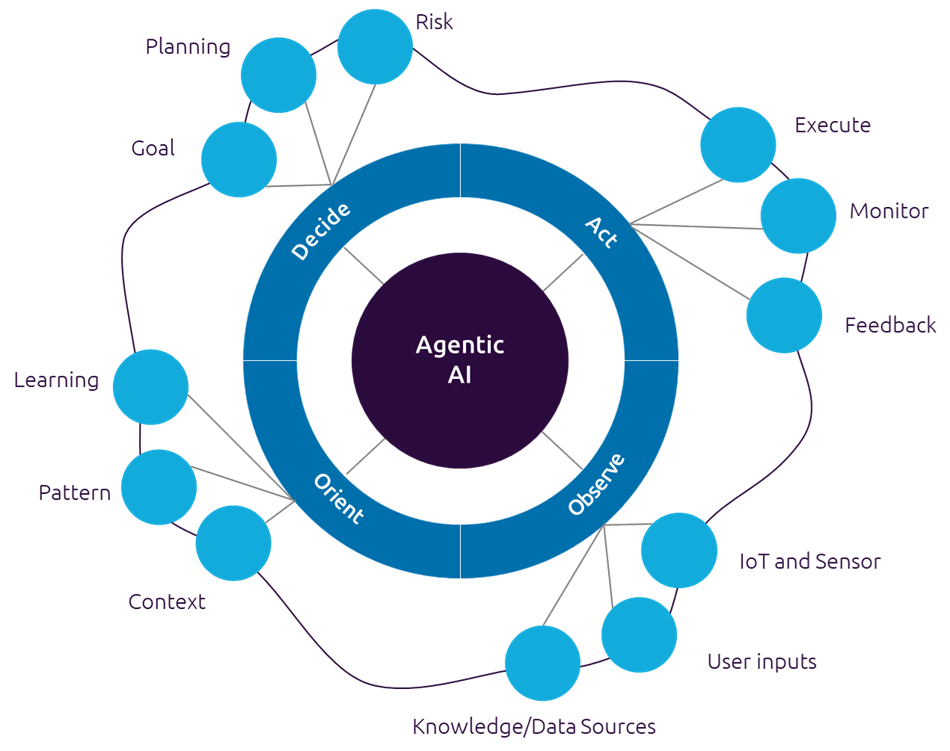In recent times, generative AI has transformed the digital landscape, enabling systems to create art, music, and insightful text on demand. However, the conversation is rapidly shifting toward multi-agent systems and the so-called agentic experience – a concept where AI evolves from merely reactive tools into proactive, autonomous partners.
Building on generative AI’s solid foundation. Drawing inspiration from the tactical mindset of fighter pilots, the OODA loop—standing for Observe, Orient, Decide, and Act—provides a dynamic framework for rapid, context-aware responses. Agentic AI leverages the OODA loop to achieve rapid, context-aware decision-making that anticipates and adapts to dynamic environments.
What is the OODA Loop?
Originally designed as a military strategy, the OODA loop stands for Observe, Orient, Decide, and Act. This decision-making cycle was developed to help fighter pilots outmanoeuvre their opponents by continuously gathering information, interpreting it, and acting swiftly. In the context of Agentic AI, the OODA loop transforms static, reactive systems into dynamic entities capable of autonomous, adaptive behavior.
Applying the OODA Loop to Agentic AI
Agentic AI systems integrate the OODA loop to enhance their autonomy and responsiveness. Here’s how each phase of the loop is reimagined in an agentic context:
1. Observe
The system actively gathers data from various sources—user inputs, sensor feeds, and internal knowledge repositories—to build a real-time picture of its environment. This proactive sensing capability forms the backbone of Agentic AI, enabling it to move beyond waiting for prompts.
2. Orient
Once the data is collected, Agentic AI interprets and contextualizes the information. Through advanced context analysis, the AI identifies key patterns and nuances, ensuring that its understanding of the situation is both deep and current.
3. Decide
Armed with comprehensive insights, the system evaluates potential actions using tools like decision matrices and risk assessment protocols. This phase is crucial for Agentic AI, as it enables the system to simulate various scenarios and select the most effective, ethical, and contextually appropriate response.
4. Act
Finally, Agentic AI executes the chosen action—be it generating content, interfacing with other systems, or performing complex tasks. The system then monitors the outcome, using feedback to refine future cycles and continuously improve its performance.

Key Benefits of the OODA Loop in Agentic AI
By incorporating the OODA loop, Agentic AI achieves several transformative advantages:
- Faster response times:
Continuous cycling through Observe, Orient, Decide, and Act enables Agentic AI to rapidly adapt to changing scenarios and user needs. - Improved decision-making:
A thorough orientation phase ensures that the AI considers context and potential outcomes, leading to more refined and effective decisions. - Enhanced adaptability:
The feedback mechanism embedded in the OODA loop allows Agentic AI to learn from each interaction, evolving its responses over time and handling diverse challenges with increasing proficiency.
A real-world example: The Agentic AI Chatbot
Consider a modern chatbot that embodies the agentic experience. Here’s how it leverages the OODA loop:
- Observe:
The chatbot continuously monitors for user input, capturing queries as soon as they are typed. It understands the context in which the conversation is happening. - Orient:
It then analyzes the input, identifies key phrases, and interprets the user’s intent using its expansive internal knowledge base. - Decide:
Based on its analysis, the chatbot simulates various agents and works on the reasoning and negotiation to get the right response scenarios and selects the most appropriate, context-aware answer. - Act:
Finally, it delivers the crafted response to the user, all the while gathering feedback to improve future interactions. It also makes sure that the appropriate action is taken depending on the user feedback and approval.
How can Sogeti help you achieve Agentic AI
We’re transforming AI—elevating traditional generative systems into agentic experiences. Our unique framework is built on three core pillars:
- Intent:
Capturing and understanding the purpose behind your data and user interactions through multi modal input, aligning with the Observe and Orient phases of the OODA loop. - Interpretation:
Deeply analyzing and contextualizing data to derive actionable insights, directly supporting the Orient and Decide stages. This step includes multi-agent negotiation, reasoning, decision making through long term memory, input information and short-term contextual knowledge. - Execution:
Executing chosen actions with precision, representing the Act phase. This phase also makes sure that the action is performed, monitored and learnings are captured for future interaction.
Our Agentic Experience Wrapper integrates seamlessly with all major hyperscalers, ensuring that, whatever your cloud platform or on-premises, we can transition your enterprise into an agentic system. This framework has been proven with customers, driving enhanced responsiveness, improved decision-making, and a proactive AI that serves as a true augmented partner in your digital transformation journey.

The evolution from generative AI to Agentic AI marks a significant shift—from systems that merely respond to external prompts to those that proactively engage with their environment. By embedding the OODA loop within their architecture, Agentic AI systems become capable of rapid, adaptive, and ethically informed decision-making. This proactive intelligence not only enhances system performance but also sets the stage for a new era of AI—a realm where technology acts as a true partner in navigating complex, dynamic challenges.
Embracing the OODA loop in Agentic AI is paving the way for innovations that will redefine how we interact with technology, making AI more responsive, intuitive, and essential in our daily lives.

 English | EN
English | EN 